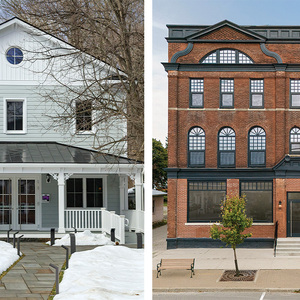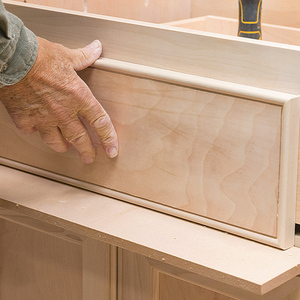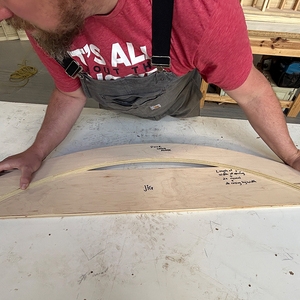Hi everybody.
I think my disposer is pumping dirty water back into the dishwasher and or the dishwasher is siphoning it back.
I did a search and was reading posts about airgaps. Posters said to run the drain hose as high as possible. My dishwasher facilitates this by placing a loop of hose high on the side. So when I installed the dishwasher I didn’t worry about an airgap. Never really had a problem.
Two months ago I replaced the disposal. Now I notice the back up more often. My question is since I have a high loop of hose and am still getting siphoning, is an airgap neeeded also?
Also, will an airgap mounted to the sink spit water and air all over the place?
Chris Webb
Chris’ Handyman Service



















Replies
bumpin my own post...
Chris Webb
Chris' Handyman Service
Looping a line high under the sink will not prevent siphonage back into the dishwasher cause it is a tight line.
Air gap fittings are designed to prevent back siphonage & will only leak on to the counter if the gravity line feed to the disposer clogs up.
"Why do you hurt me when I do bad things to you?" My youngest son to his older brother
Thanksfor the info. Will an air gap solve the problem of the disposer being full and pumping water back to the DW until the disposer pumps out?Chris Webb
Chris' Handyman Service
An airgap will prevent the disposer from pumping into the dw.
The disposer can pump up to the air gap, but will spit onto tyhe counter before it goes back into the dw.
"Why do you hurt me when I do bad things to you?" My youngest son to his older brother
Since air gaps are prone to failure due to clogging or cracking, I prefer the high loop approach. Therefore, consider re-rerouting the dw drain hose away from the disposer.
Cap off the disposer's d/w inlet, making this good and watertight.
Then cut a wye with dw drain hose barb fitting above the kitchen sink trap, in a vertical position. Route dw drain to this new fitting.
Before proceeding, make sure there is enough elevation. You may need to move the trap and trap arm further down to make room for the Wye. If the drain exits through the wall rather than the cab bottom, this may present further challenges.
Edited 12/2/2007 10:51 pm ET by Pierre1
One note about the "high loop". It should touch, or nearly touch the bottom of the counter.
I've read all the posts and my 'STRONG' advise is to follow those directions given by 'Plumbill' and forget this high hose positioning stuff cause if it going to siphon, it'll siphon no matter how high you loop the hose. Get the airgap and be done with it!
Actually if you get the loop past 28' of elevation then it will break the siphon. ;-)
"Why do you hurt me when I do bad things to you?" My youngest son to his older brother
"forget this high hose positioning stuff cause if it going to siphon, it'll siphon no matter how high you loop the hose. Get the airgap and be done with it!"
The only argument I can make against that is that I have never seen a dishwasher that has an air gap and I've never personally known anyone who had a problem with siphoning.
Rich Beckman
"I lost my license when I got caught driving without car insurance. So now I drive with Safe Auto!"Heard on a Safe Auto Insurance TV commercial
Hi everyone,
Thanks for the good info. I installed the dw about 3 years ago, and have since rechecked the hose, no kinks.
The hose doesn't make a high loop in the cabinet, but the dw mfg. placed a loop high on the side.
It seems now that the problem isn't a siphoning problem, but a situation where a user has forgotten to run the disposer and allows water to back up into the sink. I hit the switch for the disposer and the water takes the path of least resistance into the dw hose until the disposer pumps out.
So I am kind of in a quandary. I don't want to install an airgap and have it spit stuff all over.
I have pretty much decided to live with it for now, and just hit the draon button on the dw when it backs up.Chris Webb
Chris' Handyman Service
Air gaps are code in many locales because they provide a positive break between the supply side and the drain side of the plumbing system. Here, they're also required on all hose bibs.It's conceivable that a situation could arise that dirty water from the drain (disposer) could be drawn into the supply piping. This is a health issue. If the disposer is pumping into the DW. It's not being used properly. Unless yours is a "batch feed" model, the motor should be run ANYTIME you are rinsing something down the drain. It's not designed to let stuff sit in there, then run it to clear it.Personally, while I understand the rationale for the requirement, I hate the stupid air gaps. They're unattractive, use up a hole in the sink or counter, and can clog if the DW is used infrequently, causing them to 'spit' onto the counter (into the sink if you're lucky). I have mounted them outside to avoid the appearance issue- inspector passed it no prob.Bill
Bill,You mentioned hose bibs having air gaps. How can that be?My understanding of an air gap is that the point where the water discharges from the fixture must be above the flood level rim of the sink basin, tub, etc. Wouldn't a hose bib inherently have this since there is no drain below the bib? Or am I missing something entirely?
Jon Blakemore RappahannockINC.com Fredericksburg, VA
He's talking about an air admittance valve, which is a slightly different beast.
If your view never changes you're following the wrong leader
Air admittance valve is like a Studor vent, right?If so, now I'm really confused why you would put that on a hose bib when there's no drain involved. I thought Studor's were just for providing a vent when the vent stack is not accessible?
Jon Blakemore RappahannockINC.com Fredericksburg, VA
The valve prevents siphoning back up the hose in the event of a loss of water pressure. Generally they incorporate both backflow check and air admittance functions. Will tend to dribble at low pressure.
If your view never changes you're following the wrong leader
You are both wrong.He is talking about a vacum breaker. And it is much different than an air gap. But purpose is the same. To prevent contaminated water from the supply.However a vacuum breaker and an air admitance valve work very similarly, in that they open allow air in on a vacuum, but they are used in much different places and for much different purposes.But a vacuum breaker works on pressurized lines and used to prevent back syphoning on a hose if the water pressure is lost.The air admitance valve is used on drain lines and to allow air into a drain when water is draining..
.
A-holes. Hey every group has to have one. And I have been elected to be the one. I should make that my tagline.
Bill,Is a vacuum breaker the same as a check valve?I'm understanding now why a vacuum breaker is necessary. We have to an backflow prevention device when we have a irrigation system installed.
Jon Blakemore RappahannockINC.com Fredericksburg, VA
"Is a vacuum breaker the same as a check valve?"Same but different.There are several different types and styles of backflow preventers and they are rated for different types of applications, one being the amount of risk if there is backflow. For example a connection hard plumbed to tank of hazardous material need much more protection then a garden bib that might or might not be connected and if connected might or might not be on and if on might or might not be a puddle and if in a puddle most likely would not have a large concentration of hazardous chemicals.A VB is a type of check valve. CV can be may types, free swing, spring loaded, etc. But is designed to only allow a fluid to flow in one direction.A VB is a check valve that does not allow water to flow out, but allows air to flow in.http://en.wikipedia.org/wiki/Atmospheric_vacuum_breakerHere is a frostproof bib. The VB is part above the hose connection.http://www.rd.com/familyhandyman/content/18060/.
.
A-holes. Hey every group has to have one. And I have been elected to be the one. I should make that my tagline.
Thanks Bill, I poked around on Wikipedia a bit and now I'm a lot more clear on the matter.
Jon Blakemore RappahannockINC.com Fredericksburg, VA
Yes- it is a vacuum breaker- I was 'shorthanding' by referring to it as an airgap.BIll
As was suggested before the alternate hook up for your dishwasher would be what is called a "dishwasher tailpiece". A tailpiece is the first piece attached to the strainer basket, if there is room to install one between the strainer basket and the tee that receives the disposal discharge it will make a better setup for you.
You can cut some of the tail piece off if it helps get you the fit you need.
Also plug the place where the dishwasher hose is hooked now, or it will blow chunks.
An air gap is more common in a dishwasher setup several feet away from the sink, I have set some up that way, but it's more for unusual conditions than the normal setup.
Go ahead and change this if possible because there are some health issue's here.
Good luck!
Okay, thanks for the advice. As you all can probably tell, a real plumber, I ain't. I will check out what I can do space wise and use the suggestions here.
Thanks again.
Chris Webb
Chris' Handyman Service
Edited 12/5/2007 9:01 am ET by webby
I'm curious as to why something would have changed with the new disposer. We've never had an air gap and never (in 31 years here, with two different DWs and 3 different disposals) had trouble with backup into the DW.
Is it possible that your DW just isn't draining well, possibly because of a kinked hose?